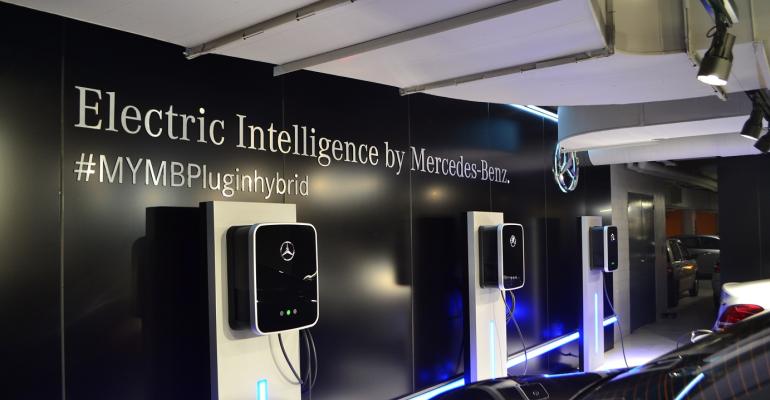A Mercedes-Benz initiative is expected to help ease a pain point among battery-electric vehicle owners: not enough public chargers to match the growth of BEV sales, according to J.D. Power’s ongoing E-Vision Intelligence Report.
The year-over-year growth rate of BEVs in operation is roughly double that of public chargers. J.D. Power calls that “a key gap.”
Mercedes-Benz plans to install approximately 10,000 high-power BEV chargers worldwide by 2027. That includes about 2,500 charge points at 400 locations across the U.S. and Canada.
The network will be open to all brands, but only Mercedes-Benz owners can pre-book a charging space.
The all-inclusive approach makes the German automaker eligible for federal funding intended to accelerate charging-network expansion.
J.D. Power says the Mercedes initiative “addresses one of the biggest barriers to EV adoption.”
BEV customer satisfaction with public charging networks has declined steadily since 2021, bottoming out at 620 (on a 1,000-point scale) in 2022.
Moreover, many existing public chargers don’t work. More than 21% of surveyed consumers say they’ve encountered malfunctioning chargers.
“These chargers are not reliable,” says Doug Betts, head of J.D. Power’s automotive division. “Public satisfaction in them has reached an all-time low.”
The U.S. Department of Energy says there are about 50,000 public BEV charging stations in the U.S., with nearly 130,000 individual charging ports.
Although the vast majority of BEV owners do their charging at home, a public network is considered vital to BEVs becoming mainstream.
Meanwhile, J.D. Power’s report says the big trend defining the BEV marketplace in 2022 was the growth in consumer interest in mass-market electrified plug-in vehicles.
In December, Chevrolet surpassed Tesla in brand-level consideration among consumers, with 44% of BEV shoppers indicating they are either “very likely” or “somewhat likely” to consider the brand for their next BEV purchase. That’s up from 31% in June 2022.
The report says Ford, Toyota and Hyundai also continue to make their presence felt in brand consideration with their full battery-electric vehicles and plug-in hybrid electric vehicles.
And Lexus, Toyota’s luxury brand, this year will debut its first fully electric vehicle, the RZ, a compact SUV that will start at $55,000.
For BEVs to succeed in the marketplace, “there is a whole lot to getting it right,” Betts says at J.D. Power’s recent Auto Summit in Dallas. “It’s a complicated subject.”
Yet, “the demand is there,” says Mike Stanton, president of the National Automobile Dealers Assn. “We’re feeling the demand. A few years ago, people were saying dealers weren’t excited about selling EVs. But it was because there wasn’t a whole lot of product.”
That’s changed. The number of currently available and soon-to-launch BEV models has grown from 27 in January 2021 to 53 today, and that’s “still just the beginning,” says J.D. Power’s report, which tracks millions of data points aggregated into six categories: interest, availability, adoption, affordability, infrastructure and experience.





